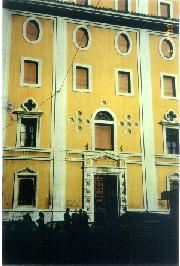
in the Church of St. Anthony Abbot, Rome
Date: Sun, 05 Oct 1997 11:21:53 +0100 From: elias <camp0012@sable.ox.ac.uk> To: cincarm <cincarm@cin.org> Subject: The Russian College in RomeGlory to Jesus Christ!

|
|
|
| Icon of St. Therese in Russicum Chapel |
|
|
| Icon of Sts Cyril and Methodius in the Church of St. Anthony Abbot, Rome |
I found this story very interesting when I first heard it, and I have come across it since from several other sources… but I have never seen it in writing anywhere, and I hesitate to tell a story so undocumented. Perhaps someone does know the whole story, and can tell me if I am wrong? Perhaps the account has been written somewhere?
St. Therese was beatified in 1923, and canonized in 1925. This process was supported and encouraged by Catholics around the world. I understand that the process of beatification and canonization of saints is a very expensive one, and the work of the relevant staff in the Papal court must be paid for by donations from those promoting the cause.
In order to make the necessary contribution to the Holy See, a collection was taken by the friars (O.Carm. as well as O.C.D.). The response was overwhelming, especially from the United States where the Catholics are known for their extraordinary generosity, which was evidently also combined with a great love for Therese.
So the O.Carm. Prior General had a sum of money left over after all the expenses of the process of canonization had been paid. Now it is not allowed to use money collected for one purpose, for any other purpose, so he asked the advice of the Holy Father, Pius XI.
Pius XI was a remarkable pope, and a great scholar. He was known especially for his support for learning and higher education. He established the Pontifical Academy of the Sciences, founded the Vatican Radio, and revolutionized Catholic teaching on Social Action, etc., etc... He also was a great promoter of missionary activity, the fruits of which are now becoming manifest around the world where the seed he planted has taken firm root; he was a man of vision.
He was not particularly ecumenical in the modern sense, but he was a strong supporter of the Eastern Catholic Churches. He also wrote against fascism and socialism, having witnessed the rise of both after the Great War.
So when the Prior General came to the Holy Father with the problem of what to do with 'Therese's money', he is reported to have said, "I know just the thing." He instructed that the money be used to construct a college in Rome for the education of priests to serve as missionaries in Russia.
The College 'Russicum' was built near St. Mary Major in Rome, and the Church of St. Antony the Great was given over to worship in the Russian Rite, with a college for seminarians built next door. (Today, the Pontifical Oriental Institute is on the other side of the Church from the Russicum College.)
The College itself known as the Russian College, or the 'Russicum', but its official title remains the 'College of St. Therese', and in the chapel used for the daily Liturgy there is a powerful icon of her on the Iconostasis in the place reserved for the patron of the place. It is a remarkable icon which conveys something quite extraordinary of her spiritual vision.
Of course, dedicating this missionary college to her is altogether in keeping with our image of Therese as co-patron of the missions (with St. Francis Xavier). However there are some problems which remain, not least of which is the rejection of 'uniatism' as a means of achieving Church unity. (This has recently been agreed by the Catholic Church in the Balamand statement of agreement with the Orthodox). So a 'mission' to the Orthodox with a view to converting them to join the Russian Rite Catholic Church is no longer a popular idea. I suppose it is related to the dispute often spoken about in the context of the 'conversion of Russia'. ...A minefield in the worse sense of that image.
In fact, since the ecumenical movement and the approaches made to the Orthodox Churches as 'sister' Churches, the Holy Father's sincere hope for closer love and even union with the Orthodox, the Russian College is suffering something of an identity crisis, not sure of how it fits in to the new vision. It is having considerable difficulty re-inventing itself. At present the Society of Jesus has care of the college, but its future is not certain.
This is a complicated matter, and beyond the scope of Cincarm (see for example Cineast). However, the connection with St. Therese is a very interesting one, and the story is possibly prophetic. The suffering Christians of Russia, and those in Russia who have yet to hear the faith preached to them, are well commended to Therese, whose intercession is needed now as much as during the years of communistic oppression.
With due apologies for this long letter. But, someone asked...
Reprinted with permission of CIN (Catholic Information Network)
